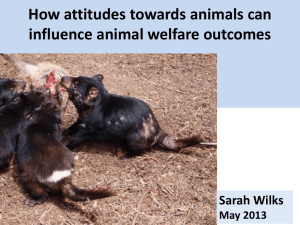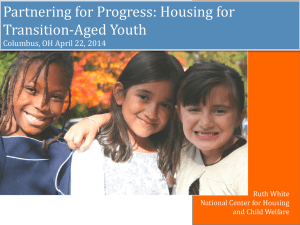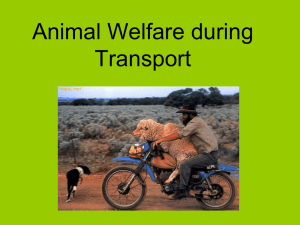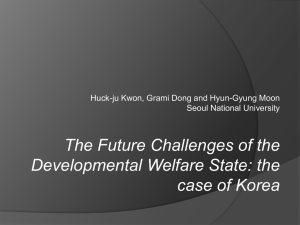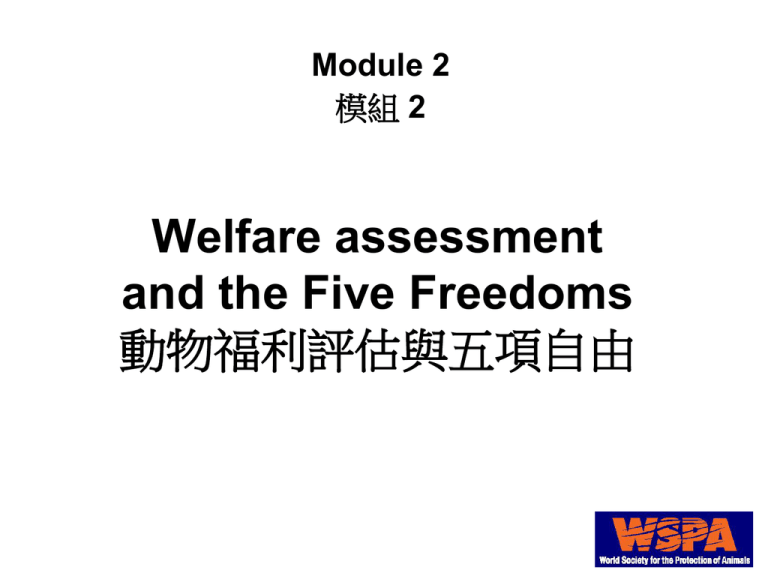
Module 2
模組 2
Welfare assessment
and the Five Freedoms
動物福利評估與五項自由
This module will enable you to
此模組將使你能夠
• Understand 了解
– the concept and potential uses of the Five
Freedoms五項自由的觀念和潛在用途
– the difference between factors affecting welfare
(inputs) and actual welfare performance
(outcome)了解影響動物福利的(因子)和(成果)之
間的差異
• Assess welfare by using Severity, Duration, and
Number Affected 使用嚴重性、持續性、影響數來評
估動物福利
• Appreciate that science can provide information on
the severity of welfare problems, but not on the
acceptability了解科學可以在動物福利問題的嚴重性
上提供資訊,但不是接受度
Assessing human welfare
評估人的福利
• Overall, how are you feeling at the
moment?
– Several different areas of life
大體上來說,目前你們的感覺如何?
– 幾個不同的生活領域
Welfare continuum
福利的連續性
Good welfare
好的福利
Poor welfare
差的福利
•
•
•
•
•
•
•
Fantastic太棒了
Pretty good很好
Reasonable合理
OK尚可
Not good不好
Miserable痛苦
Terrible可怕
Some aspects of your welfare
福利的不同觀點
Poor welfare差的福利
Chair comfort 座椅舒適度
Hungry 饑餓
Hot / cold 冷熱
Work 工作
Social life 社交
Overall 整體
Good welfare好的福利
What are the main areas of animal
welfare?什麼是動物福利主要的範圍
?
?
?
?
?
整體?
The Five Freedoms 五項自由
Farm Animal Welfare Council UK, 英國農業動物福利
委員會在1992年提議採納早期政府諮詢機構 Brambell
Committee(1965年)的建議,推行五項自由。
1.Freedom from hunger and thirst 免除飢渴的自由
2.Freedom from discomfort 免除不適的自由
3.Freedom from pain, injury and disease 免除痛病傷的自由
4.Freedom to express normal behaviour 表現正常行為的自由
5.Freedom from fear and distress 免除恐懼焦慮的自由
From: Concepts in Animal Welfare, Module 2
英國農場動物福利委員會(Farm Animal Welfare Council, UK)
在1992年提議使用Brambell Committee (1965)的建議,推行
動物以下之五項自由。
1.Freedom from hunger and thirst 免除飢渴的自由
2.Freedom from discomfort 免除不適的自由
3.Freedom from pain, injury and disease 免除痛病傷的自由
4.Freedom to express normal behaviour 表現正常行為自由
5.Freedom from fear and distress 免除恐懼焦慮的自由
From: Concepts in Animal Welfare, Module 2
The Five Freedoms & animal welfare
五項自由與動物福利
Poor差
Hunger / Thirst 餓/渴
Pain/Injury/Disease 痛/傷/病
Discomfort 不適
Fear / Distress 恐懼/緊迫
Normal behaviour 正常行為
Overall 整體
Good好
Are all Freedoms equally important?
五項自由是否同等重要?
• Producer attitude (344 farmers) –
questionnaire distributed by Tesco plc生
產者的態度(344位農夫)-由英國Tesco公司所作的問卷
• “In your opinion, how much importance
should be placed on providing animals
with the Five Freedoms?”依您的觀點來看,
給予動物五項自由有多重要?
Module 2
The importance of the Five Freedoms
to 344 UK farmers五項自由對344為英國
農民的重要
None
Some
Great
Extreme
Hunger and Thirst
Pain, Injury and Disease
Discomfort
Fear and Distress
Express Normal Behaviour
0%
25%
Module 2
50%
75%
100%
What do the results of the survey
mean?這些調查結果的意義?
• The results are not generalisable這些結果並不能一概
而論
– The proportion of concerned individuals will be
different for different groups of users and different
countries這些關注程度將會在不同的團體和文化間
有所差異
• Even in the surveyed population, there are significant
welfare problems即使在這些受訪農場中,仍然有嚴重
的動物福利問題
– For example, in the UK 20% of dairy cattle are
lame, and lamb mortality is more than 20%例如:英
國20%的乳牛有跛足,跛足有超過20%的死亡率
Module 2
Problems with Five Freedoms
五項自由的問題
• The freedoms conflict五項自由的衝突
– Keeping animals “Free from disease” can
cause them Fear and distress, from handling
during treatment 讓動物有”免於疾病的自由”可能導
致牠們在接受治療時感到恐懼和痛苦。
– If animals have “Freedom to express normal
behaviour”, they can suffer Fear and distress,
during normal social interactions如果動物有”表現
自然行為的自由”,牠們在正常的社交互動時就會承受
恐懼和痛苦。
All farming systems restrict normal
behaviour
所有的農場都會限制動物的正常行為
Restriction of ‘normal’限制正常行為
(左)顯著 - 哺育欄
Obvious - farrowing
crates
(右)不顯著 - 突起地面
Not so obvious cubicle surface
Cubicle surface & lying time
牛舍與躺臥時間 (何謂舒適度comfort)
80
60
40
%time
spent lying 20
躺臥時間
0
Soft
Mat
軟墊
Module 2
Rubber Concrete
Mat
水泥墊
塑膠墊
Significance of Five Freedoms
五項自由的意義
• Scientists & politicians in many countries agree很多
國家的科學家和政治家都同意
– Consider welfare in terms of the Freedoms就五項
自由來考慮福利
• Freedoms do not define minimum standards五項自由
並未定義最低的標準
– Very difficult to always provide all the Freedoms因
為要求全時間做到五項自由是極為困難的
• Freedoms provide an initial indication五項自由提供一
個起初指標
– what should be assessed什麼應該被評估
– what should be provided to animals什麼應該提供
給動物
Objections to the Five Freedoms
對五項自由的反對
(Korte et al 2007, in press)
• Concern ethics more than science重視倫理多於
科學
• Are anthropocentric偏向人類本位說
– Restricts the scientific investigation of animals as
sentient beings對科學研究構成障礙,因為它假定
動物是有感情的
• Are unrealistic不切實際
– Complete freedom is undesirable完全的自由並不
被接受
• Are applied very inconsistently適用範圍不一
– e.g. laboratory animals vs. farm animals
如實驗動物 vs.農場動物
Welfare Inputs & Outputs動物福利的投入和成果
STOCKMAN技師
ENVIRONMENT環境
E.g. training訓練
E.g. housing, diet房舍,
食物
ANIMAL動物
WELFARE
INPUTS投入
的福利
E.g. breeding 育
種
ANIMAL-BASED MEASURES以
動物為基礎的評估
WELFARE
Disease/production疾病/生產 Behaviour行為
OUTPUTS福
利的成果
Physiology生理
Welfare inputs動物福利的投入/因子
• Stockman動物管理員
– Empathy同理心
– Knowledge知識
– Observation skills
觀察技巧
Welfare inputs動物福利的投入/因子
• Environment環境
– Housing 畜舍
– Bedding 墊料
– Feed quality 飼料品質
– Water provision 飲水供應
• Animal動物
– Suitable breed, age, and
sex for the farming
system適合該農場使用的
動物品種、動物年齡與性
別等
The Five Freedoms & welfare inputs
五項自由和動物福利的投入
• Freedom from hunger & thirst免除飢渴的自由
– Ready access to fresh water, and a diet that maintains
full health and vigour動物應易於取得新鮮食水,並獲
得膳食,以維持充足健康與體力
• Freedom from discomfort免除不適的自由
– An appropriate environment, including shelter and a
comfortable resting area動物應該有適合的居住環境,
如藏身處和舒適的休憩處
• Freedom from pain, injury and disease免除痛病傷的自
由
– Disease prevention or rapid diagnosis and treatment
動物應接受疾病預防措施,並迅速接受診治
The Five Freedoms & welfare inputs
五項自由和動物福利的投入
• Freedom to express normal behaviour表現正常行為的
自由
– Sufficient space, proper facilities and company of the
animal’s own kind動物應有充足的空間、恰當的設施和
各自的夥伴
• Freedom from fear and distress免除恐懼焦慮的自由
– Conditions and treatment which avoid mental
suffering動物應受到避免造成精神受苦的環境與待遇
Quantifying a welfare problem
定量分析動物福利問題
• Severity嚴重性
• Duration持續性
• Number affected
受到影響的動物數
量
Measures of severity
嚴重性的評估方法
• Behaviour 行為
– e.g. fearfulness如恐懼
• Disease疾病
– e.g. lameness,
pneumonia如跛足和肺炎
• Production生殖能力
– e.g. growth rates如生長速度
• Physiology生理狀況
– e.g. heart rate, cortisol如心跳率和皮質醇含量
Severity: example 嚴重性:舉例
• How severe is the social isolation of
sheep?綿羊離群索居的嚴重程度
Severity: example (contd.)
嚴重性:舉例(續)
4.5
Vocalisations
per minute
每分鐘呼叫次數
3
1.5
0
Spatial
Isolation
Visual
Isolation
空間隔離
視線隔離
Baldock & Sibley, 1990
Severity: example (contd.)
嚴重性:舉例(續)
30
Heart rate
20
increase
(beats/min)
心跳增加
(次數/每分鐘)
10
0
Spatial
Isolation
Visual
Isolation
空間隔離
Baldock & Sibley, 1990
視線隔離
Duration: example
持續性:舉例
• For how long are sheep sensitive to
pain after a lameness episode?綿羊在跛
足事件後對痛楚的敏感度可以維持多久?
Duration: example (contd.)
持續性:舉例(續)
5
Threshold
stimulus (N)
2.5
刺激閥(N)
0
Normal
(Not lame)
正常
(未跛足)
Ley et al.1995
Lame
跛足
Three months
after lameness
cured跛足治癒
後三個月
Number affected: example
受到影響的數目
• At any one time, approximately what
percentage of UK farm animals are lame?舉
例:在某一時刻,在英國的農場動物大約有多
少是跛足的?
15%
22%
26%
Quantifying welfare:
sows in farrowing crates
量化動物福利:母豬在哺乳豬欄
Severity: Nest building & distress in
sows嚴重性:豬窩硬體和母豬的緊迫
(Lawrence et al 1994)
Pen (loose)
Farrowing crate
寬鬆的豬舍
哺乳豬欄
60
Cortisol
(ng/ml) 40
皮質醇
20
0
Baseline
基本線
During farrowing
哺乳時期
Duration: Cortisol post-farrowing
持續性:母豬分娩後的皮質醇濃度
6
Cortisol
(nmol/l)
皮質醇
4
2
0
1
7 14 21 28
Days after farrowing
哺乳後天數
Farrowing crate哺乳豬欄
• Severity 嚴重性
– Restrict freedom to move around 限制走動的自由
– Restrict freedom to nest build 限制築巢的自由
– Restrict freedom to avoid the piglets 限制避開小豬
的自由
• Duration 持續性
– 3-4 weeks 3~4週
• Number affected 受影響動物數目
– Most indoor sows in intensive systems 密集飼養系
統中之大部份母豬
Intrinsic problem內在議題
• Farrowing crates are used throughout
the world哺乳豬欄全世界都在使用
• Currently considered intrinsic
(unavoidable) in commercial indoor pig
production目前所考慮的(無法避免的)價值只
在商用室內豬的生產。
– i.e. Benefits for piglets and production
exceed Costs to the sow也就是說小豬
的生產利潤>高於母豬成本。
Quantifying welfare: thin cattle
量化動物福利:瘦牛
• Severity嚴重性
– How thin are the cattle (body condition
score)?這些牛有多瘦?(身體狀況的根據)
• Duration 持續性
– How long have they been thin?牠們這麼瘦
已經多久了?
• Number affected受影響的數目
– How many cattle are thin?多少隻牛這麼瘦?
Conclusions / Summary
結論/摘要
• Welfare can be assessed 動物福利可以被評估的
– Five Freedoms are a useful framework五項
自由是有用的指標
• Consider welfare inputs思考動物福利的投入
– Stockman, Environment, Animal管理員、環
境、動物
• Include animal-based measures以動物為本的
評估基準
– Severity, Duration and Number affected嚴
重性、持續性、受影響的數目
Further reading進修書目
• Baldock NM, Sibley RM (1990) Effects of handling and
transportation on the heart rate and behaviour of sheep. Applied
Animal Behaviour Science 28: 15-39
• Brambell Committee (1965). Report of the Technical Committee to
Enquire into the Welfare of Animals Kept under Intensive
Livestock Husbandry Systems. Command Report 2836, The
Stationery Office, London
(http://www.tsoshop.co.uk/bookstore.asp)
• Farm Animal Welfare Council (1992) FAWC updates the Five
Freedoms. Veterinary Record 131: 357
• Gregory NG (2004). Physiology and Behaviour of Animal
Suffering. Blackwell: Oxford. pp.12-21.
• Herlin AH (1997) Comparison of lying area surfaces for dairy cows
by preference, hygiene, and lying down behaviour. Swedish
Journal of Agricultural Research 27: 189-196.
• Korte SM, Olivier B, Koolhaas JM. A new animal welfare concept
based on allostasis. Physiology and Behaviour 2007 92(3):422-8.
Further reading進修書目
• Lawrence AB, Petherick JC et al (1994) The effect of
environment on behaviour, plasma cortisol and prolactin in
parturient sows. Applied Animal Behaviour Science 39:313330
• Ley SJ, Waterman AE, Livingston A (1995). A field study of the
effect of lameness on mechanical nociceptive thresholds in
sheep. Veterinary Record 137: 85-87
• Tucker CB, Weary DM (2001) Stall design: enhancing cow
comfort. Advances in Dairy Technology 13: 154-167. Available
from:
http://www.wcds.afns.ualberta.ca/Proceedings/2001/Chapter%2
013%20Weary.pdf



